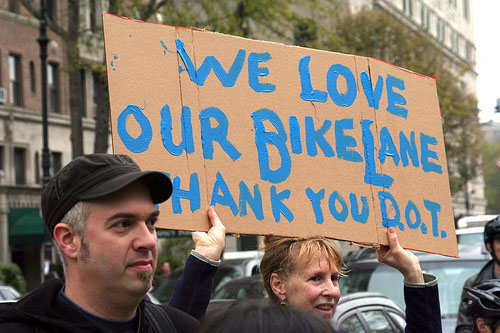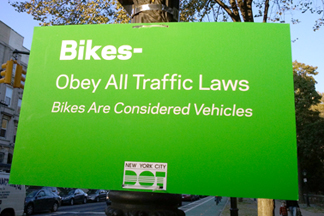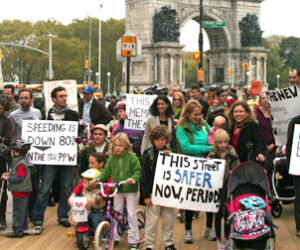More than 300 people came together early on Thursday, Oct. 21, in Grand Army Plaza to present a simple message loud and clear: “We want safe streets! We want safe streets!”

The safe street they were chanting for was Prospect Park West, which was reconfigured in June from three lanes of speeding traffic to two lanes of safer traffic and a two-way separated bike lane. The community group Park Slope Neighbors, joined by the Park Slope Civic Council and Transportation Alternatives, organized the gathering to showcase the broad spectrum of support for traffic calming and safer streets in Park Slope and beyond.
“This is a rally by people who live here, who use this bike path, who use this street as pedestrians every day, and drive on this street,” said Eric McClure, campaign coordinator for Park Slope Neighbors. “Drivers know it’s safer now than before.”
“What we have here is a major achievement,” said Civic Council President Michael Cairl. “The Park Slope Civic Council supported the reconfiguration of Prospect Park West, and we’re delighted to see it in place.
“It’s essential that everybody — pedestrians, cyclists, and motorists — get around the neighborhood safely and enjoyably,” he added.
The rally was in response to a protest the same day by a group called Seniors for Safety against the reshaped street, claiming it was hazardous for the community. Only about 50 to 75 people showed up at the group’s staging area on Carroll Street, less than a quarter the number of those gathered in Grand Army Plaza in support of the street.
Supporters of safer streets were Park Slope residents of all ages, as well as people who use Prospect Park West to get to other parts of the borough. They waved pro-traffic-calming signs reading “The Street Is Safer Now, Period,” “I Don’t Bike and the Lanes I Like,” and “I (heart) PPW.”

Besides, McClure noted, the Seniors are wrong about this street’s safety. In March of this year, prior to reconfiguration, his group clocked average traffic speeds on a Saturday afternoon at 37.6 mph. About 75% of drivers were going above the city’s 30-mph speed limit; 30% were above 40 mph, a speed at which pedestrians only have a 20% chance of survival after a crash.
Park Slope Neighbors repeated the study in July, about a month after the new configuration was completed. “Only 15% of cars were above the speed limit,” he said. “That’s an 80% reduction in speeding.”
Overall, the reconfiguration has made it easier for people to cross Prospect Park West, has helped bike riders — especially younger ones — feel safer, and has slowed traffic to more manageable levels. Eric Rochow, a 45-year-old house painter, was quoted in the New York Times as saying: “I drive my car for work, I ride my bike for work, and I walk my dogs every morning. They said come protest the bike lane and I said, ‘Why? Before they put the bike lane in, it was a superhighway.’”
“This change is great for the neighborhood,” Cairl said. “It’s a great victory for safe streets in Brooklyn.”
— Written and photographed by David Herman
DOT and NYPD announce new programs for greater safety on the road
A few hours after the competing rallies, the city’s Department of Transportation and Police Department unveiled new safety initiatives for pedestrians, motorists, and cyclists.
The NYPD received a $150,000 federal grant for increased enforcement against motorists failing to yield at crosswalks, which was cited in 27% of fatal pedestrian crashes, and traveling at unsafe speeds. Part of the grant will also be put toward enforcement of traffic laws among bicyclists who ride on the sidewalk, disobey traffic lights, and travel the wrong way on the street.
 The DOT, meanwhile, announced various efforts to increase speed limit awareness and promote safety for pedestrians. One example of the latter is countdown timers at crosswalks for major intersections, including Fourth Avenue and Ninth Street in Park Slope. (DOT is also planning to install more of these timers on Fourth Avenue from Flatbush Avenue to 65th Street.)
The DOT, meanwhile, announced various efforts to increase speed limit awareness and promote safety for pedestrians. One example of the latter is countdown timers at crosswalks for major intersections, including Fourth Avenue and Ninth Street in Park Slope. (DOT is also planning to install more of these timers on Fourth Avenue from Flatbush Avenue to 65th Street.)
Perhaps the most visible part of these initiatives are TV commercials that remind drivers the speed limit is 30 mph. “It’s 30 for a reason,” said DOT Commissioner Janette Sadik-Khan. “Even 10 miles per hour too fast can mean the difference between life and death. As we make our safe streets even safer for everyone who uses them, every New Yorker needs to follow all the rules of the road whether in a car, on foot, or on a bike.” — DH
from the October 2010 Civic News

